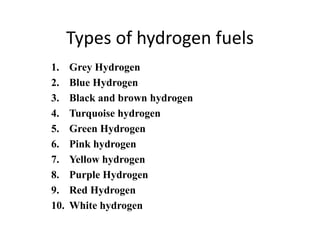
hydrogen fuels.pptx
- 1. Types of hydrogen fuels 1. Grey Hydrogen 2. Blue Hydrogen 3. Black and brown hydrogen 4. Turquoise hydrogen 5. Green Hydrogen 6. Pink hydrogen 7. Yellow hydrogen 8. Purple Hydrogen 9. Red Hydrogen 10. White hydrogen
- 2. Grey hydrogen • Currently, this is the most common form of hydrogen production. Grey hydrogen is created from fossil fuels (natural gas, methane) biogas, using steam methane reformation process but without capturing the greenhouse gases made in the process.
- 3. Blue hydrogen • It is also produced in a same process as grey hydrogen except by following the carbon capture and storage (CCS).
- 4. Black and brown hydrogen • Using black coal or lignite (brown coal) in the hydrogen- making process, these black and brown hydrogen are the absolute opposite of green hydrogen in the hydrogen spectrum and the most environmentally damaging. In this method hydrogen is produced by gasification coal method. • If we use black coal hydrogen produced is called black hydrogen and if we use brown colored lignite as a source it’s called brown hydrogen.
- 5. Turquoise hydrogen • Turquoise hydrogen is made using a process called methane pyrolysis to produce hydrogen and solid carbon. • In the future, turquoise hydrogen may be valued as a low-emission hydrogen, dependent on the thermal process being powered with renewable energy and the carbon being permanently stored or used.
- 6. Pink hydrogen • Pink hydrogen is generated through electrolysis powered by nuclear energy.
- 7. Yellow hydrogen • In this method hydrogen made through electrolysis using solar power.
- 8. Purple hydrogen • In this method hydrogen is made using nuclear power and heat as combined form in a process called thermochemical water splitting (High temperature electrolysis)
- 9. Red hydrogen • Red hydrogen is produced through the high-temperature catalytic splitting of water using nuclear power as thermal energy source.
- 10. White hydrogen • It is a naturally occurring geological hydrogen found in underground deposits and created through fracking.
- 11. Green hydrogen • green hydrogen is the one produced with no harmful greenhouse gas emissions. • Green hydrogen is made by using clean electricity from surplus renewable energy sources, such as solar or wind power, to electrolyse water. • Electrolysers use an electrochemical reaction to split water into its components of hydrogen and oxygen, emitting zero-carbon dioxide in the process. • Green hydrogen currently makes up a small percentage of the overall hydrogen because production is expensive.
- 12. Generation of green hydrogen Green hydrogen is hydrogen produced by splitting water by electrolysis. This produces only hydrogen and oxygen. We can use the hydrogen and vent the oxygen to the atmosphere with no negative impact. Electrolysis is a promising option for carbon-free hydrogen production from renewable and nuclear resources. Electrolysis is the process of using electricity to split water into hydrogen and oxygen. This reaction takes place in a unit called an electrolyzer. Electrolyzers can range in size from small, appliance-size equipment that is well-suited for small-scale distributed hydrogen production to large-scale, central production facilities that could be tied directly to renewable or other non- greenhouse-gas-emitting forms of electricity production.
- 13. Working • Like fuel cells, electrolyzers consist of an anode and a cathode separated by an electrolyte. Different electrolyzers function in different ways, mainly due to the different type of electrolyte material involved and the ionic species it conducts. • Diagram:
- 14. Types of electrolyzers Polymer Electrolyte Membrane Electrolyzers Alkaline Electrolyzers Solid Oxide Electrolyzers
- 15. Polymer Electrolyte Membrane Electrolyzers • In a polymer electrolyte membrane (PEM) electrolyzer, the electrolyte is a solid specialty plastic material. • Water reacts at the anode to form oxygen and positively charged hydrogen ions (protons). • The electrons flow through an external circuit and the hydrogen ions selectively move across the PEM to the cathode. • At the cathode, hydrogen ions combine with electrons from the external circuit to form hydrogen gas. Anode Reaction: 2H2O → O2 + 4H+ + 4e- Cathode Reaction: 4H+ + 4e- → 2H2
- 16. Alkaline Electrolyzers • Alkaline electrolyzers operate via transport of hydroxide ions (OH-) through the electrolyte from the cathode to the anode with hydrogen being generated on the cathode side. • Electrolyzers using a liquid alkaline solution of sodium or potassium hydroxide as the electrolyte have been commercially available for many years. • Newer approaches using solid alkaline exchange membranes (AEM) as the electrolyte are showing promise on the lab scale.
- 17. Solid Oxide Electrolyzers Solid oxide electrolyzers, which use a solid ceramic material as the electrolyte that selectively conducts negatively charged oxygen ions (O2-) at elevated temperatures, generate hydrogen in a slightly different way. Steam at the cathode combines with electrons from the external circuit to form hydrogen gas and negatively charged oxygen ions. The oxygen ions pass through the solid ceramic membrane and react at the anode to form oxygen gas and generate electrons for the external circuit. Solid oxide electrolyzers must operate at temperatures high enough for the solid oxide membranes to function properly (about 700°–800°C, compared to PEM electrolyzers, which operate at 70°–90°C, and commercial alkaline electrolyzers, which typically operate at less than 100°C). Advanced lab-scale solid oxide electrolyzers based on proton-conducting ceramic electrolytes are showing promise for lowering the operating temperature to 500°–600°C. The solid oxide electrolyzers can effectively use heat available at these elevated temperatures (from various sources, including nuclear energy) to decrease the amount of electrical energy needed to produce hydrogen from water.